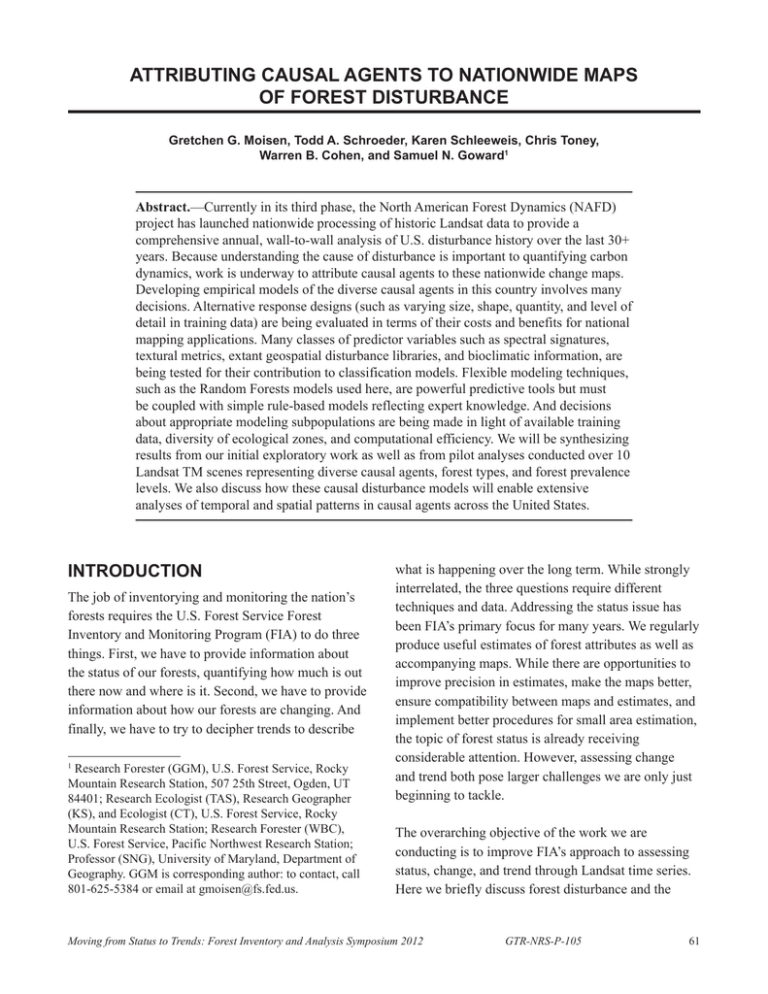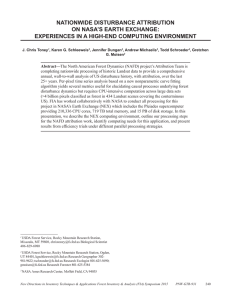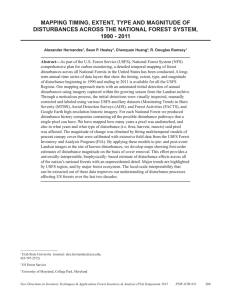ATTRIBUTING CAUSAL AGENTS TO NATIONWIDE MAPS OF FOREST DISTURBANCE
advertisement

ATTRIBUTING CAUSAL AGENTS TO NATIONWIDE MAPS OF FOREST DISTURBANCE Gretchen G. Moisen, Todd A. Schroeder, Karen Schleeweis, Chris Toney, Warren B. Cohen, and Samuel N. Goward1 Abstract.—Currently in its third phase, the North American Forest Dynamics (NAFD) project has launched nationwide processing of historic Landsat data to provide a comprehensive annual, wall-to-wall analysis of U.S. disturbance history over the last 30+ years. Because understanding the cause of disturbance is important to quantifying carbon dynamics, work is underway to attribute causal agents to these nationwide change maps. Developing empirical models of the diverse causal agents in this country involves many decisions. Alternative response designs (such as varying size, shape, quantity, and level of detail in training data) are being evaluated in terms of their costs and benefits for national mapping applications. Many classes of predictor variables such as spectral signatures, textural metrics, extant geospatial disturbance libraries, and bioclimatic information, are being tested for their contribution to classification models. Flexible modeling techniques, such as the Random Forests models used here, are powerful predictive tools but must be coupled with simple rule-based models reflecting expert knowledge. And decisions about appropriate modeling subpopulations are being made in light of available training data, diversity of ecological zones, and computational efficiency. We will be synthesizing results from our initial exploratory work as well as from pilot analyses conducted over 10 Landsat TM scenes representing diverse causal agents, forest types, and forest prevalence levels. We also discuss how these causal disturbance models will enable extensive analyses of temporal and spatial patterns in causal agents across the United States. INTRODUCTION The job of inventorying and monitoring the nation’s forests requires the U.S. Forest Service Forest Inventory and Monitoring Program (FIA) to do three things. First, we have to provide information about the status of our forests, quantifying how much is out there now and where is it. Second, we have to provide information about how our forests are changing. And finally, we have to try to decipher trends to describe Research Forester (GGM), U.S. Forest Service, Rocky Mountain Research Station, 507 25th Street, Ogden, UT 84401; Research Ecologist (TAS), Research Geographer (KS), and Ecologist (CT), U.S. Forest Service, Rocky Mountain Research Station; Research Forester (WBC), U.S. Forest Service, Pacific Northwest Research Station; Professor (SNG), University of Maryland, Department of Geography. GGM is corresponding author: to contact, call 801-625-5384 or email at gmoisen@fs.fed.us. 1 what is happening over the long term. While strongly interrelated, the three questions require different techniques and data. Addressing the status issue has been FIA’s primary focus for many years. We regularly produce useful estimates of forest attributes as well as accompanying maps. While there are opportunities to improve precision in estimates, make the maps better, ensure compatibility between maps and estimates, and implement better procedures for small area estimation, the topic of forest status is already receiving considerable attention. However, assessing change and trend both pose larger challenges we are only just beginning to tackle. The overarching objective of the work we are conducting is to improve FIA’s approach to assessing status, change, and trend through Landsat time series. Here we briefly discuss forest disturbance and the Moving from Status to Trends: Forest Inventory and Analysis Symposium 2012 GTR-NRS-P-105 61 challenges it poses for monitoring. We also provide an overview of the most recent phase of the North American Forest Dynamics (NAFD) project with emphasis on attribution of causal agents. FOREST DISTURBANCE AND MONITORING Forest disturbance is becoming increasingly important to the inventory and monitoring audience. Although it affects only a small percentage of a given forest each year, there are cumulative effects through time. It is a complicated phenomenon in that it can impact canopy, understory, as well as forest floor. The definition of disturbance changes dramatically depending on an individual’s perspective and area of expertise. People are having an increasing influence on the frequency and severity of disturbances across the landscape. Consequently, monitoring in ways that improve our understanding of the role of disturbance in our forests is increasingly important. Disturbances brought on by different causal agents vary in terms of the speed with which they affect a forest and the length of time that the effects persist. For example, urbanization doesn’t happen overnight, but once it occurs, it is permanent. Conversely, floods happen quickly, but they can recede equally as fast. Disturbances caused by a variety of agents are also dramatically different in terms of the size of area affected and the severity or magnitude of change they inflict on the forest in that area. For example, the death of one tree is small relative to the area in a 30 m pixel, but it is very severe for that individual tree. Urbanization is also a severe change but occurs over much larger areas. Thinking about disturbance in this way brings out three key points. First, the timing of observation can be critical to detection. Second, the spatial scale of observation on the ground can influence our ability to detect disturbance. And finally, the techniques we use to observe or measure will also factor into the ability to discern different types of disturbance. Can we really see it with our eyes? Can we “see it” with the spectral bands that our remote sensing instrument is equipped with? Understanding the diversity of disturbance raises issues about how forests are monitored. The advantages of field data collection are well understood and appreciated. FIA produces unbiased estimates at broad scales, the sampling error is well understood, and the measurement error can be assumed to be negligible for many variables that we can physically measure (wrapping a tape, observing a species). However, these estimates are not spatially explicit except at very coarse spatial grains such as counties. In addition, our inventory frequency might cause us to miss some disturbance events, identifying year of disturbance can be problematic, and when observing from the ground, it can be difficult to detect disturbances that affect only crowns. Conversely, using remotely-sensed information such as dense time series of Landsat imagery offers some advantages for monitoring disturbance, such as a 16day repeat cycle and 40-year historical archive. The 30 m grain size and spectral bands are adequate for capturing many changes in the landscape, and there is no sampling error because of wall-to-wall coverage. In addition, historic Landsat data can be interpreted visually with the aid of periodic photos to give very detailed information about forest history to augment information collected on the plots themselves. However, measurement error in the observations collected by Landsat can be highly variable and is often poorly understood. DISTURBANCE ATTRIBUTION IN NAFD PHASE 3 Funded under the North American Carbon Program (NACP), the NAFD is a collaborative project that began nearly a decade ago and in its first two phases grew to include many partners including University of Maryland, National Aeronautics and Space Administration (NASA), FIA, the U.S. Forest Service Pacific Northwest and Northern Research Stations, Canadian and Mexican partners, and others. Because of the NACPs interest in determining the role of forest dynamics in the North American carbon balance Moving from Status to Trends: Forest Inventory and Analysis Symposium 2012 GTR-NRS-P-105 62 (USCCSP 2007), the NAFD group was funded to study disturbance patterns and recovery rates of forests across the continent. The approach taken in NAFD phase 1 and 2 was to process a complete time series (1985-2008) on a sample of Landsat scenes, resulting in biennial (in phase 1) and annual (in phase 2) maps of forest disturbance (Goward et al. 2008). FIA data were used for calibration and validation. A third phase of NAFD was launched in the summer of 2011 and consists of three major components. The first component of Phase 3 involves conducting an annual, wall-to-wall analysis of U.S. disturbance history between1985-2010 (Huang et al. 2010). The second component includes conducting a detailed validation of the national disturbance map using TimeSync (Cohen et al. 2010). The third component consists of exploring variations in post-disturbance forest recovery trajectories using repeat measurements from FIA plot data following Masek et al. 2008. Causal agent groups are also being modeled in the final annual disturbance product (with beginning work from Schroeder et al. 2011 and Schleeweis et al., in press). Our pilot phase, which began in January 2012, is designed to address a number of issues through analyses conducted over 10 pilot Landsat scenes which were chosen to represent a diverse set of disturbance regimes and forest types across the country (Fig. 1). NAFD Phase 3 Attribution Modeling Pilot Sites FIA Forest Group Type map from Ruefenacht et al. 2008 Figure 1.— Ten sample scenes selected for pilot testing causal attribution methods for North American Forest Dynamics (NAFD) Project Phase 3. Scenes were selected to capture a variety of causal agents in diverse forest types. Moving from Status to Trends: Forest Inventory and Analysis Symposium 2012 GTR-NRS-P-105 63 Issues being addressed in this pilot phase include: choosing the target population, identifying realistic classes to be modeled, testing which predictor variables contribute to our empirical models, choosing between pixel or polygon modeling objects, and combining empirical and rule-based models for the improved predictions. Results from these pilot tests will be presented in December 2012. CONCLUSION One take-home message from this overview relates to FIA and collaboration. Increasingly, various groups are approaching FIA requesting access to plot coordinates to conduct a wide variety of research. What is different about the NAFD project is that it involved FIA as full partners in research and helped to secure funding to support our involvement. This has resulted in more than the FIA logo on maps or names of FIA scientists on numerous publications. It has resulted in FIA expanding its capacity through acquisition of new tools, and more importantly, new people and talent within the organization. ACKNOWLEDGMENTS This research was supported in part by the North American Carbon Program, NASA grant NNH11AR18I. LITERATURE CITED Cohen, W.B.; Zhiqiang, Y.; Kennedy, R.E. 2010. Detecting trends in forest disturbance and recovery using yearly landsat time series: 2. TimeSync-tools for calibration and validation. Remote Sensing of Environment. 114: 2911-2924. Goward, S.N.; Masek, J.G.; Cohen, W.; Moisen, G.G.; Collatz, G.J., Healey, S.; Houghton, R.; Huang, C.; Kennedy, R.; Law, B.; Powell, S.; Turner, D.; Wulder, M.A. 2008. Forest disturbance and North American carbon flux. Eos Transactions. 89: 105-116. Huang, C.; Goward, S.N.; Masek, J.G.; Thomas, N.; Zhu, Z.; Vogelmann, J.E. 2010. An automated approach for reconstructing recent forest disturbance history using dense Landsat time series stacks. Remote Sensing of Environment. 114: 183-198. Masek, J.G.; Huang, C.Q.; Wolfe, R.; Cohen, W.; Hall, F.; Kutler, J.; Nelson, P. 2008. North American forest disturbance mapped from a decadal Landsat record. Remote Sensing of Environment. 112: 2914-2926. Ruefenacht, B.; Finco, M.V.; Nelson, M.D.; Czaplewski, R.; Helmer, E.H.; Blackard, J.A.; Holden, G.R.; Lister, A.J.; Salajanu, D.; Weyermann, D.; Winterberger, K. 2008. Conterminous U.S. and Alaska forest type mapping using forest inventory and analysis data. Photogrammetric Engineering and Remote Sensing. 74(11): 1379-1388. Schleeweis, K.; Goward, S. N.; Huang, C.; Kennedy, R. E.; Masek, J. G.; Moisen, G.; Thomas, N. [In press]. Regional dynamics of forest canopy change and underlying causal processes in the conterminous US. Journal of Geophysical Research–Biogeosciences. Schroeder, T.A.; Wulder, M.A.; Healey, S.P.; Moisen, G.G. 2011. Mapping wildfire and clearcut harvest disturbances in boreal forests with Landsat time series data. Remote Sensing of Environment. 115: 1421-1433. USCCSP. 2007. The first state of the carbon cycle report (SOCCR): the North American carbon budget and implications for the global carbon cycle. A report of the U.S. Climate Change Science Program and the Subcommittee on Globl Change Research. Ashville, NC: National Oceanic and Atmospheric Administration, National Climatic Data Center. 242 p. The content of this paper reflects the views of the author(s), who are responsible for the facts and accuracy of the information presented herein. Moving from Status to Trends: Forest Inventory and Analysis Symposium 2012 GTR-NRS-P-105 64

